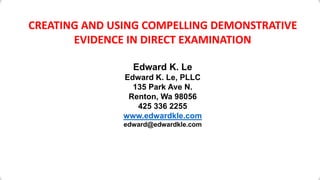Using Demonstrative Evidence At Trial
- 1. CREATING AND USING COMPELLING DEMONSTRATIVE EVIDENCE IN DIRECT EXAMINATION Edward K. Le Edward K. Le, PLLC 135 Park Ave N. Renton, Wa 98056 425 336 2255 www.edwardkle.com edward@edwardkle.com
- 2. DO YOU KNOW WHAT SCARES ME MOST ABOUT TRIALS?
- 3. IT’S NOT THE OPPOSING ATTORNEY
- 4. IT’S NOT THE JUDGE
- 5. IT’S THESE PEOPLE – MY JURORS
- 6. OR MORE SPECIFICALLY THIS – JUROR BOREDOM
- 7. SO WHAT IS MY ANSWER TO THIS PROBLEM? DEMONSTRATIVE EVIDENCE WHY?
- 8. DEMONSTRATIVE EVIDENCE HOLDS ATTENTION OF YOUR JURORS & CREATE BETTER RECALL
- 9. VISUAL AUDITORY REPETITION EVIDENCE IS NOT JUST PRESENTING A FACT – IT’S ABOUT CREATING IMPRESSIONS ABOUT A FACT
- 10. IT IS TO EVOKE ANGER, ENTHUSIASM, EMPATHY, AND/OR DISGUST
- 11. DEMONSTRATIVE EVIDENCE BOLSTERS CREDIBILITY OF YOUR EXPERT
- 14. STAIRS WITH & WITHOUT CONTRAST
- 15. STAIRS OF NEARBY APARTMENTSTAIRS OF DEFENDANT’S APARTMENT
- 16. DIFFERENCE IN ABILITY TO GRASP
- 17. DEMONSTRATIVE EVIDENCE HELPS ME ATTACK CREDIBILITY OF THE OPPOSING MEDICAL EXPERT
- 19. IT HELPS ME EXPLAIN CONCEPTS
- 20. CRASH “OTHER FACTORS” PRE-EXISTING SUSCEPTIBILITY OR WEAR AND TEAR CURRENT DISABILITY LIKE THE “PROXIMATE CAUSE” JURY INSTRUCTION
- 21. LIKE HOW MANY EPIDURAL INJECTIONS MY CLIENT WENT THROUGH
- 22. IT HELPS ME EXPLAIN THE CHOICES THAT ARE AVAILABLE TO A DEFENDANT BEFORE AN INCIDENT OCCURRED 1 2 3 4
- 25. AND TO HUMANIZE MY CLIENTS
- 26. SO WHERE CAN YOU FIND THE RIGHT DEMONSTRATIVE EVIDENCE FOR YOUR CASE
- 27. FROM TREATING DOCTORS AND MEDICAL EXPERT SIMPLY CONCEPTS
- 29. SAMPLE USE OF DEMONSTRATIVE EVIDENCE
- 33. FUNCTIONAL CAPACITY CONCEPTS STANDING LIFTING SQUATTING BENDING
- 34. Activities of Daily Living WALKING RUNNING MOST TWISTING MOVEMENTS EVEN SLEEP
- 41. Functionality Ongoing Medical Care Needs Quality of Life Earlier Nursing Home Enrollment Activities of Dailiy Living
- 43. Prior to accident, Income was rising. After the accident, earnings dropped. $- $5,000.00 $10,000.00 $15,000.00 $20,000.00 $25,000.00 $30,000.00 $35,000.00 $40,000.00 $45,000.00 2004 2005 2006 2007 2008 2009 2010 Date of Injury: July 20, 2009
- 44. Overtime Hours - Before Accident v. After Accident 0 50 100 150 200 250 300 350 400 450 500 2006 2007 2008 2009 2010 Date of Injury: July 20, 2009
- 48. FINAL TIPS ON USING DEMONSTRATIVE EVIDENCE
- 49. 1. REHEARSE WITH YOUR WITNESS FIRST
- 50. 2. MOVE TO PREADMIT THE EXHIBIT
- 51. 3. AND ABOVE ALL ELSE…




















































